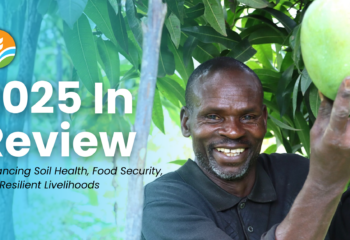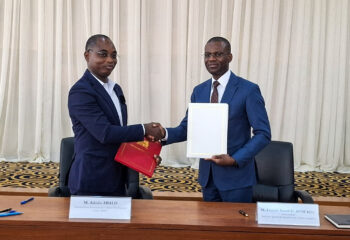February 17, 2011 – MUSANZE, Rwanda – Dr. Ben Knapen, Dutch State Secretary of Foreign Affairs (European cooperation and development cooperation), and Dr. Agnes Kalibata, Rwanda Minister of Agriculture and Animal Resources (MINAGRI), visited the Imbaraga Farmers’ Federation, a partner organization of IFDC’s CATALIST project in Cyuve Sector, Musanze District of Rwanda, on Tuesday, Feb. 15. The Dutch Secretary of State was accompanied by the Dutch Ambassador to Rwanda, His Excellency Frans Makken, a delegation from The Hague and a team from the Netherlands Embassy in Rwanda.
In her introductory speech, Minister Kalibata described the Government of Rwanda’s policies and plans to transform the agricultural sector of the country. She explained that the improved performance of the agricultural sector is attributable mainly to the government’s bold move of implementing the Green Revolution program.
Members of Imbaraga told the delegation about what they have accomplished since 2007, when they began partnering with and receiving technical support from the CATALIST project. Joseph Gafaranga, Imbaraga’s Executive Secretary in the Northern Province, talked about the three farmers who began field tests of Integrated Soil Fertility Management (ISFM).
ISFM is the key to increasing agricultural productivity while protecting the environment and maintaining (or even enhancing) the soil resource base. ISFM strategies center on the combined use of mineral fertilizers and locally available organic amendments (crop residues, compost and green manure) to replenish lost soil nutrients. This improves both soil quality and the efficiency of fertilizers and other agricultural inputs (seeds, crop protection products and water). In addition, ISFM promotes improved crop management practices, measures to control erosion and leaching and techniques to improve soil organic matter maintenance. Farmers who have adopted ISFM technologies have more than doubled their agricultural productivity and increased their farm-level incomes by 20 to 50 percent.
Previously, most Imbaraga farmers raised beans, sorghum and maize on their 30-are plots (1 are = 100 square meters; 1 hectare = 100 ares or 10,000 square meters). They used traditional seed varieties and had very low yields; they also did not know how to calculate profitability at the time. They estimate that average production of maize was 700 kilograms per hectare (kg/ha; 1,000 kilograms = one metric ton.) With CATALIST, average maize production is five metric tons per hectare (mt/ha) and potatoes average 25 mt/ha. To date, the maximum potato yield obtained with ISFM is 33 mt/ha. According to Gafaranga, the reasons such high yields have been achieved are collaboration among stakeholders and the use of agricultural inputs, such as fertilizers and improved seeds, and good farming practices such as disease control, crop rotation, etc. Collaboration was among Imbaraga, MINAGRI (through its Crop Intensification Program and Land Use Consolidation Policy), MINAGRI’s subsidized fertilizers and seeds program, Rwanda’s Institute of Agricultural Sciences (ISAR) that facilitates access to improved seeds (which will reduce seed imports in the area by one-third) and IFDC (technical support, training and technology transfer).
According to Gafaranga, about 2,000 Imbaraga North farmers have adopted ISFM on 1,200 ha today. Farmers are very happy with their impressive increase in production. He emphasized that this results from collaboration among IFDC, MINAGRI, private input dealers and the district’s and sector’s local authorities.
Marketing of increased yields is not an issue. For example, the Mukamira maize processing plant is an outlet for the surplus in crop production that resulted from the use of ISFM. Seeds produced by Imbaraga’s seed multipliers are sold to the Rwanda Agricultural Development Agency (RADA) and to the United Nations Food and Agriculture Organization (FAO).
In terms of impact, the increase in productivity has enabled farmers to build modern houses, pay for “muteul de santé” (mutual health insurance) and buy land and cattle. Gafaranga concluded by expressing heartfelt gratitude on behalf of the federation’s members to the Government of the Netherlands for the funding provided to the CATALIST project, which has enabled them to improve their livelihoods and develop the federation for common benefits. He also used the opportunity to thank Minister Kalibata, the MINAGRI, ISAR, the District of Musanze and IFDC.
When Minister Kalibata asked Imbaraga’s members what achievements they wanted to share with Minister Knapen and his delegation, Pétronille Bemeriki eagerly talked about how ISFM has spread from three Imbaraga farmers in 2007 to over 2,000 farmers today. “Profit from selling our harvest allows us to easily pay our children’s school fees,” she said. Bemeriki also can now buy herself nice clothes. She shared how membership in Imbaraga is making it possible for members to have electricity in their homes.
Secretary Knapen commended the “impressive collaboration between MINAGRI, Imbaraga and CATALIST.” He also commented on how impressive it is that such results were achieved within just three to four years. “My congratulations for your efforts. I urge you to maintain your collaboration, continue to improve your crop yields and to build your agricultural value chains,” Knapen concluded.




